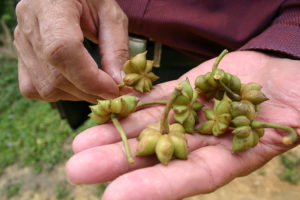
Star Anise Tree
Star Anise is the dried fruit of an evergreen tree (Illicium verum) that is native to southern China and northern Vietnam. It is an important ingredient of Chinese Five Spice powder as well as Vietnamese Pho soup. In India, it is used in biryani and masala chai.
The flavor is similar to anise but the two plants are unrelated. Star anise is used in Western cuisine as a less expensive substitute for anise. Anise is also used in flavoring liqueurs such as sambuca and absinthe.
Star anise has an important place in modern Western medicine. It is a source of shikimic acid that is used in the production of Tamiflu. The acid is extracted from the seeds in a manufacturing process that has ten stages and takes up to a year to complete.

Unripe Star Anise Fruit
The trees are members of the magnolia family and are only hardy in tropical climates where they can grow 10 to 15 feet in height. They need full sun and well-drained soil. The flowers are small and can be pink or purple. Trees will begin to bear fruit, which is a rust color, when they reach five years in age. The fruit is harvested before it ripens and then dried.
Star Anise can be used in cooking whole or ground. If used ground, the taste will be more intense. When cooking with whole pods, you should remove the pods before serving. Both the dried pods and the ground spice should be stored in an air tight container in a cool, dark place. The dried pods will retain their flavor up to one year while the ground spice will only remain flavorful for about six months.
It is important not to confuse star anise with Japanese star anise (Illicium anisatum) which is toxic and causes seizures and damage to the urinary tract, kidneys and digestive tract when eaten. In Japan, it is not ingested It is burned as incense.

